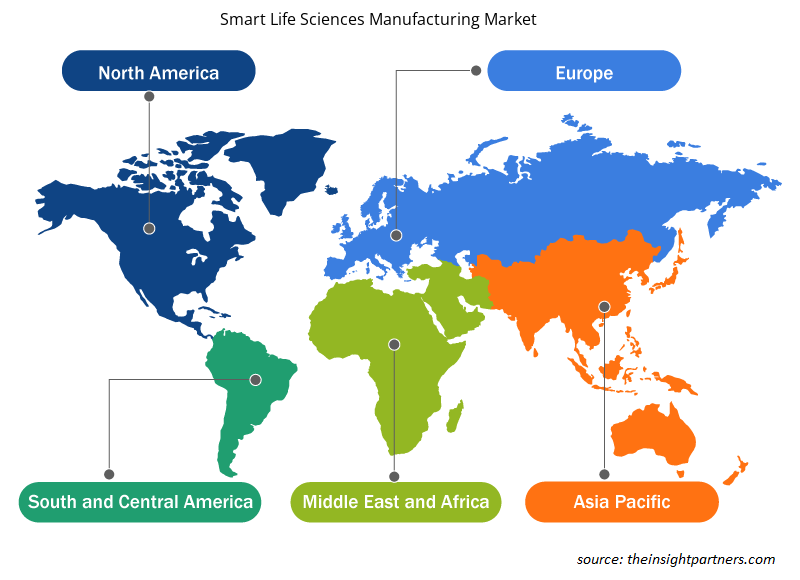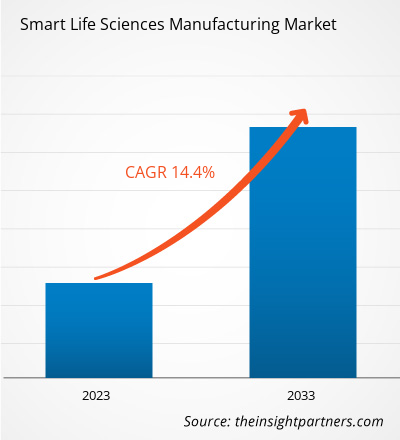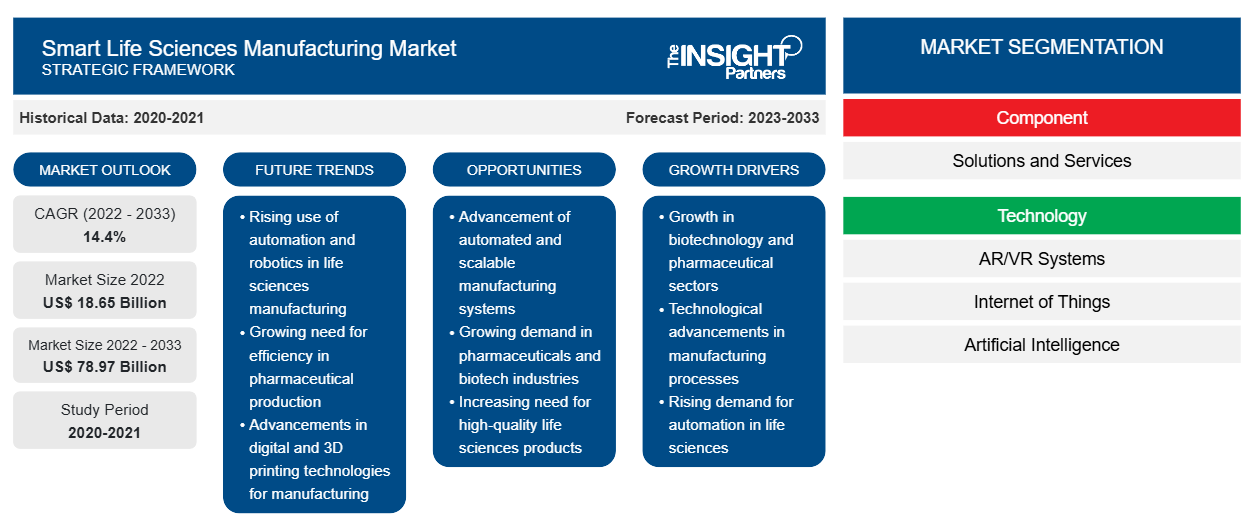Der Markt für intelligente Biowissenschaftsfertigung soll von 18.649,50 Millionen US-Dollar im Jahr 2022 auf 78.974,61 Millionen US-Dollar im Jahr 2033 anwachsen; für den Zeitraum 2023–2033 wird eine durchschnittliche jährliche Wachstumsrate (CAGR) von 14,4 % erwartet.
Der Herstellungsprozess in den Biowissenschaften hat sich in den letzten zehn Jahren erheblich verändert. Die Herstellung in den Biowissenschaften ist ein komplexer Prozess. Ein Smart-Factory-Konzept, das Maschinen und Systeme am Produktionsstandort miteinander verbindet, kann den Herstellungsprozess vereinfachen. Das System ist auch mit dem Kunden, dem Partner und dem Produktionsstandort verbunden. Nach der COVID-19-Pandemie begannen viele Hersteller von Pharmazeutika und Medizinprodukten, Pharma 4.0 einzuführen, insbesondere aufgrund zunehmender Vorschriften und Inspektionsbedenken. Smart Life Sciences Manufacturing, oft als Pharma 4.0 bezeichnet, zielt darauf ab, praktische Anleitungen bereitzustellen, regulatorische Best Practices einzubetten und die Pharma 4.0-Transformationen zu beschleunigen. Das Hauptziel besteht darin, Organisationen, die am Lebenszyklus pharmazeutischer Produkte beteiligt sind, die Möglichkeit zu geben, das volle Potenzial der Digitalisierung zu steuern und schnellere therapeutische Innovationen und verbesserte Produktionsprozesse zum Nutzen der Endverbraucher bereitzustellen. Diese Änderungen werden den Herstellern von Biowissenschaften in den kommenden Jahren enorme Chancen eröffnen. Moderne Datenanalysetools haben es Biotechnologieforschern ermöglicht, prädiktive Analysemodelle zu erstellen und die effektivsten Wege zur Erreichung ihrer Ziele und Vorgaben zu verstehen. Big Data, KI, virtuelle Realität, Datenvisualisierung und Datensicherheit gehören zu den gängigen Technologien, die in Biotech-Laboren verwendet werden. Solche Faktoren dürften den Markt für intelligente Biowissenschaftsfertigung in den kommenden Jahren stark anwachsen lassen.
Markt für intelligente Biowissenschaftsfertigung –
Passen Sie diesen Bericht Ihren Anforderungen an
Sie erhalten kostenlose Anpassungen an jedem Bericht, einschließlich Teilen dieses Berichts oder einer Analyse auf Länderebene, eines Excel-Datenpakets sowie tolle Angebote und Rabatte für Start-ups und Universitäten.
-
Holen Sie sich die wichtigsten Markttrends aus diesem Bericht.Dieses KOSTENLOSE Beispiel umfasst eine Datenanalyse von Markttrends bis hin zu Schätzungen und Prognosen.
Markteinblicke – Markt für intelligente Biowissenschaftsfertigung
Das Pharmasegment ist ein wichtiger Beitrag zum globalen Industriesektor. Darüber hinaus steigen die Nachfrage und der Verkauf von Medikamenten täglich. Daher investieren Pharmaunternehmen enorme wirtschaftliche Ressourcen in Forschung und Entwicklung, um Innovationen auf den Markt zu bringen. Technologie-Upgrades sind der Schlüssel zur Bewältigung zukünftiger Produktionsprobleme. Damit erlangt der Pharma 4.0-Markt weltweit große Aufmerksamkeit. Im Juni 2022 weihte GSK, ein britisches Big Pharma, seine neue aseptische Smart-Manufacturing-Anlage in Barnard Castle, England, ein. Diese vollautomatische Anlage nutzt die Digitalisierung, um den Herstellungsprozess zu rationalisieren. Dies wiederum würde es GSK ermöglichen, die Markteinführung neuer Medikamente zu beschleunigen und gleichzeitig Abfall zu reduzieren. Im Dezember 2020 kündigte die Bayer AG die Einführung einer Zell- und Gentherapieplattform innerhalb ihrer Pharmasparte an. Diese Plattform wird mehrere Backbone-Funktionen kombinieren, um die gesamte Wertschöpfungskette der Forschung und Entwicklung von Zell- und Gentherapien zu unterstützen . Im November 2020 begann Großbritannien mit dem Bau einer „Fabrik der Zukunft“, um die Produktion niedermolekularer Medikamente zu erneuern. Es wird erwartet, dass Arzneimittelhersteller, akademische Einrichtungen, Gesundheitsdienstleister und Regulierungsbehörden in der Einrichtung zusammenkommen, um neue Technologien, darunter kontinuierliche, digitale und autonome Fertigung, zu testen und zu verbessern. Daher wird erwartet, dass die zunehmende Einführung der digitalen Transformation den Markt für intelligente Fertigung im Bereich der Biowissenschaften vergrößern wird.
Komponentenbasierte Erkenntnisse
Der Markt für intelligente Fertigung in Biowissenschaften ist nach Komponenten in Lösungen und Dienstleistungen unterteilt. Das Segment Lösungen wird im Prognosezeitraum voraussichtlich einen größeren Marktanteil im Bereich der intelligenten Fertigung in Biowissenschaften halten, obwohl es langsamere Wachstumsraten als das Segment Dienstleistungen verzeichnet. Die Pharmaindustrie setzt die digitale Transformation schnell um, da die Digitalisierung den Prozessen Flexibilität und Effizienz verleiht. Angesichts der zunehmenden Komplexität von Produktionssystemen und -prozessen ist die Herstellung von Interkonnektivität und die Bereitstellung robuster Smart-Factory-Lösungen im Einklang mit den guten Herstellungspraktiken (GMP) zu einer strategischen Priorität für Unternehmen der Biowissenschaften geworden. Darüber hinaus hat Industrie 4.0 den Prozess des Zugriffs auf Betriebsdaten vereinfacht und es Unternehmen ermöglicht, gezielte Leistungskennzahlen (KPIs) zu erreichen. Intelligente Fertigungslösungen unterstützen das Qualitätsmanagement, indem sie Temperatur und Luftfeuchtigkeit des Lagerbestands überwachen, die End-to-End-Prozesstransparenz überwachen, die Produktkonsistenz verbessern und spezifische Probleme im Zusammenhang mit der Chargenherstellung identifizieren. Die Biowissenschaftsbranche beschäftigt sich mit der Entwicklung neuartiger, wirksamer, qualitativ hochwertiger und präziser Behandlungen. Pioniere der Branche erkunden neue Therapiebereiche und Ansätze, indem sie die neuesten technologischen Fortschritte nutzen, um sich einen Wettbewerbsvorteil zu verschaffen. Solche Faktoren treiben das Wachstum des Marktes für intelligente Fertigung in Biowissenschaften für das Segment Lösungen voran.
Der Markt für intelligente Biowissenschaftsfertigung ist nach Komponenten, Technologie und Anwendung segmentiert. Basierend auf den Komponenten ist der Markt in Lösungen und Dienstleistungen unterteilt. Nach Technologie ist der Markt für intelligente Biowissenschaftsfertigung in Augmented Reality/Virtual Reality (AR/VR)-Systeme, Internet der Dinge (IoT) , künstliche Intelligenz (KI), Cybersicherheit, Big Data und andere segmentiert. Das IoT-Segment hatte 2022 den größten Marktanteil bei der intelligenten Biowissenschaftsfertigung. Basierend auf der Anwendung ist der Markt für intelligente Biowissenschaftsfertigung in Pharma, Biopharma und Medizingeräte segmentiert. Basierend auf der Geografie ist der Markt für intelligente Biowissenschaftsfertigung hauptsächlich in Nordamerika, Europa, Asien-Pazifik (APAC), den Nahen Osten und Afrika (MEA) und Südamerika (SAM) segmentiert. ABB Ltd, Bosch Rexroth AG, Emerson Electric Co, Fortinet Inc, General Electric Co, Honeywell International Inc, IBM Corporation, Rockwell Automation, Siemens AG und Sophos Group plc gehören zu den wichtigsten Akteuren auf dem Markt für intelligente Biowissenschaftsfertigung.
Regionale Einblicke in den Markt für intelligente Biowissenschaftsfertigung
Die regionalen Trends und Faktoren, die den Markt für intelligente Biowissenschaftsfertigung im Prognosezeitraum beeinflussen, wurden von den Analysten von Insight Partners ausführlich erläutert. In diesem Abschnitt werden auch die Marktsegmente und die Geografie für intelligente Biowissenschaftsfertigung in Nordamerika, Europa, im asiatisch-pazifischen Raum, im Nahen Osten und Afrika sowie in Süd- und Mittelamerika erörtert.

- Erhalten Sie regionale Daten zum Markt für die Herstellung intelligenter Biowissenschaften
Umfang des Marktberichts zur Herstellung intelligenter Biowissenschaften
| Berichtsattribut | Details |
|---|---|
| Marktgröße im Jahr 2022 | 18,65 Milliarden US-Dollar |
| Marktgröße bis 2033 | 78,97 Milliarden US-Dollar |
| Globale CAGR (2022 - 2033) | 14,4 % |
| Historische Daten | 2020-2021 |
| Prognosezeitraum | 2023–2033 |
| Abgedeckte Segmente |
Nach Komponente
|
| Abgedeckte Regionen und Länder |
Nordamerika
|
| Marktführer und wichtige Unternehmensprofile |
|
Dichte der Marktteilnehmer im Bereich Smart Life Sciences Manufacturing: Die Auswirkungen auf die Geschäftsdynamik verstehen
Der Markt für Smart Life Sciences Manufacturing wächst rasant, angetrieben durch die steigende Endverbrauchernachfrage aufgrund von Faktoren wie sich entwickelnden Verbraucherpräferenzen, technologischen Fortschritten und einem größeren Bewusstsein für die Vorteile des Produkts. Mit steigender Nachfrage erweitern Unternehmen ihr Angebot, entwickeln Innovationen, um die Bedürfnisse der Verbraucher zu erfüllen, und nutzen neue Trends, was das Marktwachstum weiter ankurbelt.
Die Marktteilnehmerdichte bezieht sich auf die Verteilung von Firmen oder Unternehmen, die in einem bestimmten Markt oder einer bestimmten Branche tätig sind. Sie gibt an, wie viele Wettbewerber (Marktteilnehmer) in einem bestimmten Marktraum im Verhältnis zu seiner Größe oder seinem gesamten Marktwert präsent sind.
Die wichtigsten Unternehmen auf dem Markt für intelligente Biowissenschaftsfertigung sind:
- ABB Ltd
- Bosch Rexroth AG
- Emerson Electric Co
- Fortinet Inc
- General Electric Co
Haftungsausschluss : Die oben aufgeführten Unternehmen sind nicht in einer bestimmten Reihenfolge aufgeführt.

- Überblick über die wichtigsten Akteure auf dem Markt für intelligente Biowissenschaftsfertigung
Die Akteure auf dem Markt für intelligente Biowissenschaftsfertigung konzentrieren sich vor allem auf Partnerschaften, um Mehrwert für den Kunden zu schaffen.
- Im Februar 2023 unterzeichnete Theragent, ein Zelltherapie-CDMO, der sich auf die Weiterentwicklung von Krebs- und seltenen Krankheitsbehandlungen der nächsten Generation konzentriert, einen mehrjährigen Exklusivvertrag mit Insight68, einem KI-gesteuerten Softwareanbieter, der den Herstellungsprozess von Zelltherapien digitalisieren und rationalisieren will. Die Partnerschaft unterstreicht Theragents Engagement für eine 100-prozentige Einhaltung digitaler Chargenprotokolle und stärkt den Ruf des Unternehmens als führender CDMO in der aktuellen Transformation der Biopharma-Produktion.
- Im Dezember 2022 gab Hovione eine strategische Zusammenarbeit mit GEA für Advanced Continuous Tableting bekannt. Hovione ist ein Unternehmen, das sich mit der Industrialisierung und Demokratisierung neuer pharmazeutischer Technologien beschäftigt. Es bietet amorphe feste sprühgetrocknete Dispersionen an, die in zuverlässige und skalierbare Angebote umgewandelt werden, die allen zur Verfügung stehen.
- Historische Analyse (2 Jahre), Basisjahr, Prognose (7 Jahre) mit CAGR
- PEST- und SWOT-Analyse
- Marktgröße Wert/Volumen – Global, Regional, Land
- Branchen- und Wettbewerbslandschaft
- Excel-Datensatz
Aktuelle Berichte
Erfahrungsberichte
Grund zum Kauf
- Fundierte Entscheidungsfindung
- Marktdynamik verstehen
- Wettbewerbsanalyse
- Kundeneinblicke
- Marktprognosen
- Risikominimierung
- Strategische Planung
- Investitionsbegründung
- Identifizierung neuer Märkte
- Verbesserung von Marketingstrategien
- Steigerung der Betriebseffizienz
- Anpassung an regulatorische Trends























 Kostenlose Probe anfordern für - Markt für intelligente Life-Science-Fertigung
Kostenlose Probe anfordern für - Markt für intelligente Life-Science-Fertigung